Books
Books
published in 2022

Archive Dora Diamant #4
A collection of photographs from the archives of the icon of underground and alternative Parisian nights Dora Diamant.
A self-taught photographer, Dora Diamant has left thousands of photos. The Dora Diamant Association, custodian of this archive, and Éditions L'Amazone have joined forces to bring them to life by devoting a series of publications to them. Each volume of the Dora Diamant Archive was created by a different person and is the result of a subjective selection and arrangement specific to its author.
Photos: Dora Diamant
Sélection: Sonia DeVille
Dessin: Marilou Chabert
Edité par Archive Dora Diamant, Paris & Editions l'Amazone, Bruxelles, 2022
1ère édition - 300 exemplaires
Format 18 x 26 cm - 30 pages
Papier Magno Gloss 150g - couverture 300g

Archive Dora Diamant #3
A collection of photographs from the archives of the icon of underground and alternative Parisian nights Dora Diamant.
A self-taught photographer, Dora Diamant has left thousands of photos. The Dora Diamant Association, custodian of this archive, and Éditions L'Amazone have joined forces to bring them to life by devoting a series of publications to them. Each volume of the Dora Diamant Archive was created by a different person and is the result of a subjective selection and arrangement specific to its author.
Photos: Dora Diamant
Sélection & dessin: Apollo Thomas
Edité par Archive Dora Diamant, Paris & Editions l'Amazone, Bruxelles, 2022
1ère édition - 300 exemplaires
Format 18 x 26 cm - 60 pages
Papier Magno Gloss 150g - couverture 300g
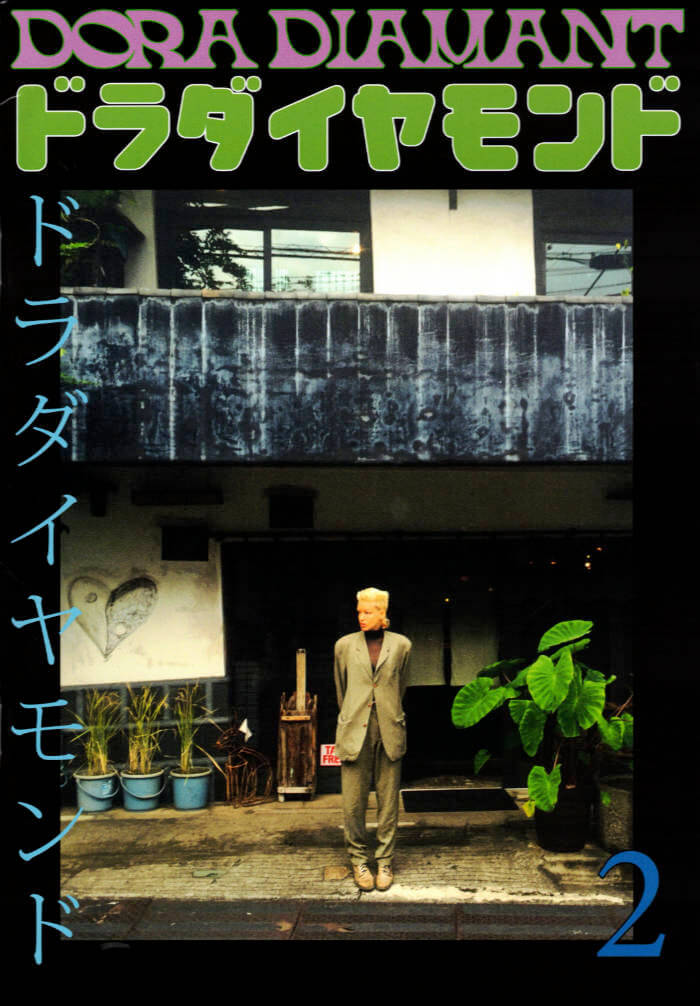
Archive Dora Diamant #2
A collection of photographs from the archives of the icon of underground and alternative Parisian nights Dora Diamant.
A self-taught photographer, Dora Diamant has left thousands of photos. The Dora Diamant Association, custodian of this archive, and Éditions L'Amazone have joined forces to bring them to life by devoting a series of publications to them. Each volume of the Dora Diamant Archive was created by a different person and is the result of a subjective selection and arrangement specific to its author.
Photos: Dora Diamant
Sélection: Carlotta & Valentine Bailly-Borg
Dessins: Carlotta Bailly-Borg
Edité par Archive Dora Diamant, Paris & Editions l'Amazone, Bruxelles, 2022
1ère édition - 300 exemplaires
Format 18 x 26 cm - 64 pages
Papier Magno Gloss 150g - couverture 300g

Archive Dora Diamant #1
A collection of photographs from the archives of the icon of underground and alternative Parisian nights Dora Diamant.
A self-taught photographer, Dora Diamant has left thousands of photos. The Dora Diamant Association, custodian of this archive, and Éditions L'Amazone have joined forces to bring them to life by devoting a series of publications to them. Each volume of the Dora Diamant Archive was created by a different person and is the result of a subjective selection and arrangement specific to its author.
Photos: Dora Diamant
Sélection: Antoine Trapp
Texte: Clara Pacotte
Edité par Archive Dora Diamant, Paris & Editions l'Amazone, Bruxelles, 2022
1ère édition - 300 exemplaires
Format 18 x 26 cm - 64 pages
Papier Magno Gloss 150g - couverture 300g
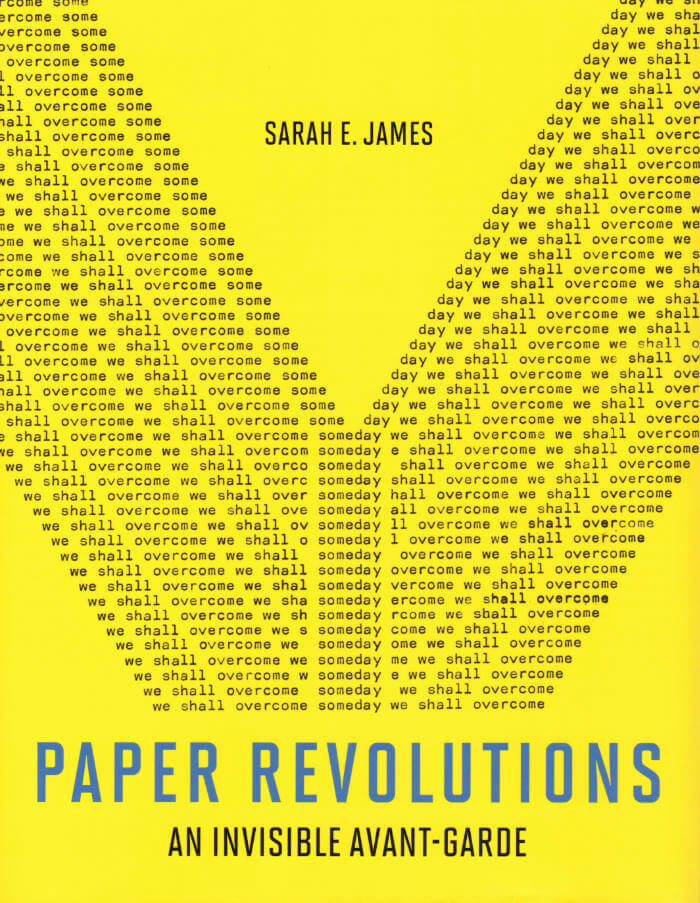
Paper Revolutions
The experimental practices of a group of artists in the former East Germany upends assumptions underpinning Western art's postwar histories.
In Paper Revolutions, Sarah James offers a radical rethinking of experimental art in the former East Germany (the GDR). Countering conventional accounts that claim artistic practices in the GDR were isolated and conservative, James introduces a new narrative of neo-avantgarde practice in the Eastern Bloc that subverts many of the assumptions underpinning Western art's postwar histories. She grounds her argument in the practice of four artists who, uniquely positioned outside academies, museums, and the art market, as these functioned in the West, created art in the blind spots of state censorship. They championed ephemeral practices often marginalized by art history: postcards and letters, maquettes and models, portfolios and artist's books. Through their “lived modernism,” they produced bodies of work animated by the radical legacies of the interwar avant-garde.
James examines the work and daily practices of the constructivist graphic artist, painter, and sculptor Hermann Glöckner; the experimental graphic artist and concrete and sound poet Carlfriedrich Claus; the mail artist, concrete poet, and conceptual artist Ruth Wolf-Rehfeldt; and the mail artist, “visual poet,” and installation artist Karla Sachse. She shows that all of these artists rejected the idea of art as a commodity or a rarefied object, and instead believed in the potential of art to create collectivized experiences and change the world. James argues that these artists, entirely neglected by Western art history, produced some of the most significant experimental art to emerge from Germany during the Cold War.

The Soft Layer
A performance text by Jozef Wouters, The Soft Layer traces and proposes visions and words that enfold the historic building of Dar Bairam Turki in Tunis like a cloak. How can we imagine possible futures for such a place and the community inhabiting it, beyond nostalgia and the spectres of the past? Several voices muse in three languages (Tunisian, French and English) on renovation and history, destruction and cleansing, the limits of science-fiction and the soothing quality of aloe vera.
Published by Varamo Press in the essay series Gestures
First edition May 2022
48 pages, 11.0 x 16.5 cm, sewn perfect binding
ISBN 978-82-691492-4-1

Plant Magic - Poison∼Remedy
Plant Magic gathers writers, artists, poets, illustrators, plant-and-mushroom-lovers and ecological thinkers, to share their experiences, knowledges, and stories around plant and mushroom magic. Oscillating between poison and remedy, plants and mushrooms reconcile ambivalences. They are powerful agents that are unpredictable in their existence and effects. They hold potential for resistance, intelligence and knowledge beyond human understanding.
When we look at plants and mushrooms we see hope amongst ecological grief. Every day we witness this magic of growing organisms, transformation and resilience. We are looking to them for guidance while still learning to listen to their silent, sensual ways. Often, the act of listening itself can calm our buzzing minds and raging hearts and make meaning blossom in a wordless way. In this publication, you might encounter stories of creating relationships with plants and mushrooms, fungal intimacy, poetic love letters to plants, herbal spells, stories of becoming postcolonial mushrooms, tips for combating the disturbing presence of scorpions, an essay introducing you to psychedelic becoming and many visual contributions of more-than-human relations.
[Publishers' note]
Contributors: Aimilia Efthimiou, Anais-karenin, Anı Ekin Özdemir, Avant Garden, Bastian Carstensen, Carla Di Girolamo, Coline-Lou Ramonet Bonis, Corinne Wiss, Cory Papalardo, Ella Ponizovsky Bergelson, Freia Kuper, Freya Häberlein, Indra Leonard Frings, Ko-Fan Lin, Leonie Brandner, Lucie Feigl, Lucila Pacheco Dehne, Marta Orlando, Maya Land, Monaline Mourbat, Nicola van Straaten, Nina Berfelde, Rafa Cunha, Rahel Preisser, Sara Blosseville, Shani Leseman, Yasmine Ostendorf, Sigourney Pilz, Totholz 5d, Xrysafeniax

William Wegman: Writing by Artist
The long-awaited compendium of Wegman's hilarious, ingenious writings and language-centric art, from the early 1970s to the present.
While he's famous the world over for his instantly recognizable images of Weimaraner dogs, William Wegman has long been one of Conceptual art's true innovators. Filled with previously unknown and wildly entertaining texts, drawings and early photos, Writing by Artist is the first collection to focus on Wegman's longstanding and deeply funny relationship to language.
This career-spanning edition presents a thematically organized selection of rediscovered writings dating back to the 1970s and 1980s, alongside landmark early photographs and hilarious drawings from throughout his career. All of the works brilliantly incorporate words in one form or another, altering logic and pushing the boundaries of what artist writing can be. Writing by Artist serves as a genuine epiphany for those only familiar with his later work, and a welcome reminder of his madcap inventiveness for the already enlightened. What you do or don't know about William Wegman now conveniently fits into this strangely beguiling book.
William Wegman was born in 1943, in Holyoke, Massachusetts. He received a BFA in painting from the Massachusetts College of Art, Boston, in 1965 and an MFA in painting from the University of Illinois, Champagne-Urbana, in 1967. By the early '70s, Wegman's work was being exhibited in museums and galleries internationally. In addition to solo shows with Sonnabend Gallery in Paris and New York, Situation Gallery in London and Konrad Fisher Gallery in Düsseldorf, his work was included in such seminal exhibitions as When Attitudes Become Form and Documenta V, and was regularly featured in Interfunktionen, Artforum and Avalanche magazines. Wegman has created film and video works for Saturday Night Live and Nickelodeon, and his video segments for Sesame Street have appeared regularly since 1989. In 1995, Wegman's film The Hardly Boys was screened at the Sundance Film Festival. Wegman has appeared on The Tonight Show with Johnny Carson and with Jay Leno, The David Letterman Show and The Colbert Report.
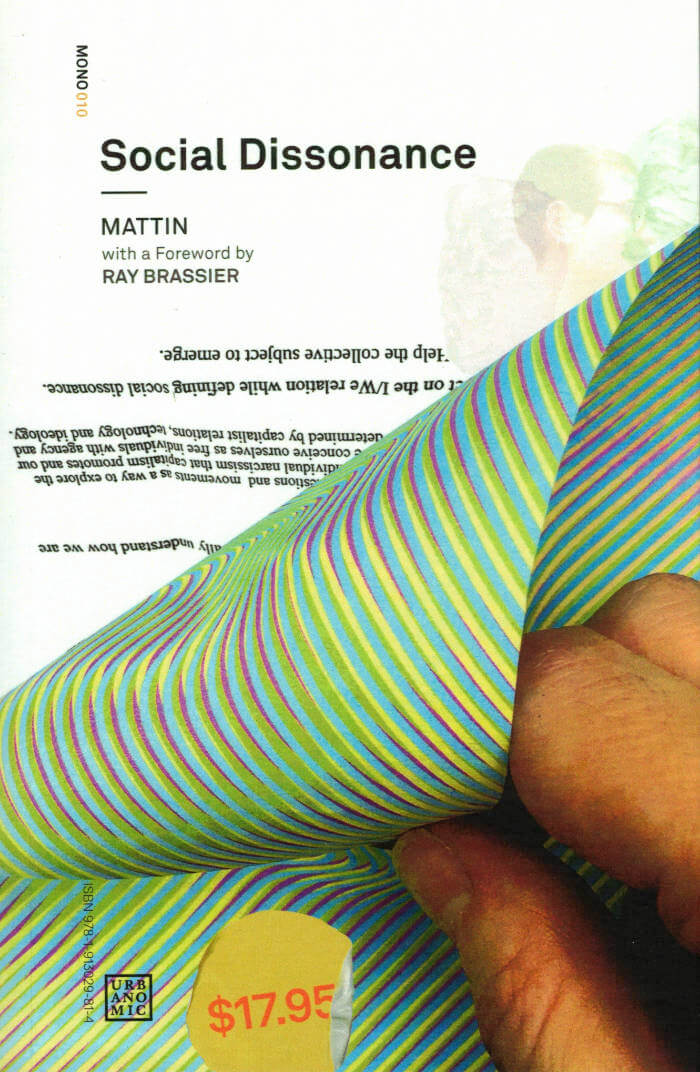
Social Dissonance
An argument that by amplifying alienation in performance, we can shift the emphasis from the sonic to the social.
Works in sound studies continue to seek out sound "itself" — but, today, when the aesthetic can claim no autonomy and the agency of both artist and audience is socially constituted, why not explore the social mediation already present within our experience of the sonorous? In this work, artist, musician, performer, and theorist Mattin sets out an understanding of alienation as a constitutive part of subjectivity and as an enabling condition for exploring social dissonance — the discrepancy between our individual narcissism and our social capacity.
Mattin's theoretical investigation is intertwined with documentation of a concrete experiment in the form of an instructional score (performed at documenta 14, 2017, in Athens and Kassel) which explores these conceptual connotations in practice, as players use members of the audience as instruments, who then hear themselves and reflect on their own conception and self-presentation. Social Dissonance claims that, by amplifying alienation in performance and participation in order to understand how we are constructed through various forms of mediation, we can shift the emphasis from the sonic to the social, and in doing so, discover for ourselves that social dissonance is the territory within which we already find ourselves, the condition we inhabit.

Sforzando - Pastels 2020 - 2022
At midday, March 17th, 2020, Macron’s government decided to place France in suspended animation. Total confinement. The first in a series of strict debilitating lockdowns to combat the spiralling Covid-19 pandemic. This first confinement lasted 55 days. It ended on 11th May 2020. The first part of a dramatic trilogy.
One month in, in April 2020, David West picked up a box of pastels that used to belong to his mother. He had had them for many years but never used them. New to the medium, locked in his Paris studio, he sets himself to the task. Naturally, violence ensues. Folk horror. Animals are disembowelled. Faceless sexualised female bodies perform. Screaming faces educate. Covered figures stand motionless. Shadows. Hooded beings populate. Stabbing, scratching, fading, softening, sforzando. Crescendo. Schadenfreude.
Occasional respite comes when West ventures outside - andante - but the externalised screaming pushes him back in. Hagazussa. Ghosts from West’s past, real and unreal, appear and disappear, figures and shapes, compositional arcs, a slimy snaking emerald hand parts the waves for colour to gush forth a new language verde fosforescente, worm purple, rosa shocking, vermillion, cobalt, ultra-black.
This book reproduces a small selection of some 300 works, in chronological order, in an attempt to document time, evolution, revolt, epiphany and joy. Joy in colour, horror, form, symphony, and finally, West’s visions of a new utopia. Marcato. Decrescendo.
Softcover (21cm x 29.7cm)
100 Pages
50 copies
Signed and numbered by David West

A conversation, Nick Zedd & Marie Canet
“What happened to my book?”
This was the last email we received from Nick, in December 2021. A short, concise demand, which we responded to, telling him that the transcription was coming soon and that Marie was finalising the introduction. Little did we know, what Nick surely already knew: he was dying. The urgency should have given it away, but Nick was always blunt in our email exchanges.
Nick passed away on February 27th, 2022. We regret not getting the transcription to him while he could still edit it, so this book in your hands remains an unabridged testament.
The only thing he did edit were his final words, in an unsolicited email in September 2021:
“I was thinking about when you asked me if I had any final words, that it would be better to have me say: Freedom or death. At the crossroads. With a key.”
So we leave you with this; a homage to the legendary founder of the Cinema Of Transgression - a brilliant artist, a sharp mind, a loving father, a kind revolutionary, a boot stamping on the face of modernity forever, an underground phenomenon.
Nick Zedd, rest in peace.
[Note by the publisher.]
With a foreword by Goswell Road. Includes a conversation with Nick Zedd, and the manifesto 'Cinema of Transgression'.
Softcover (11 cm x 18 cm)
84 Pages
75 copies
Language : English

The Jacques Lacan Foundation
It’s fall (or autumn) 2018. The Trump administration wants to fortify the United States-Mexico border, Robert ‘Beto’ O'Rourke is running for Senate, and British grifter Nicki Smith has just secured a “low-paid glamour job” at the University of Texas’ Jacques Lacan Foundation. In between sleeping with the air-conditioning repair guy (or man) and watching Kate Moss make-up commercials (or advertisements) Nicki completes the first ever American-English translation of Lacan’s newly discovered and highly controversial notebook – without knowing any French.
An Anglo-American comedy of manners about identity and class The Jacques Lacan Foundation reveals—and revels in—the numerous pretensions that surround academia and authorship, and the institutions that foster them.

Taalbarrière
The book Taalbarrière brings together reproductions of a drawing's series linked to an audio creation about the border and the language barrier in Belgium through the eyes of secondary school pupils who are learning the language of the other community, French or Dutch.
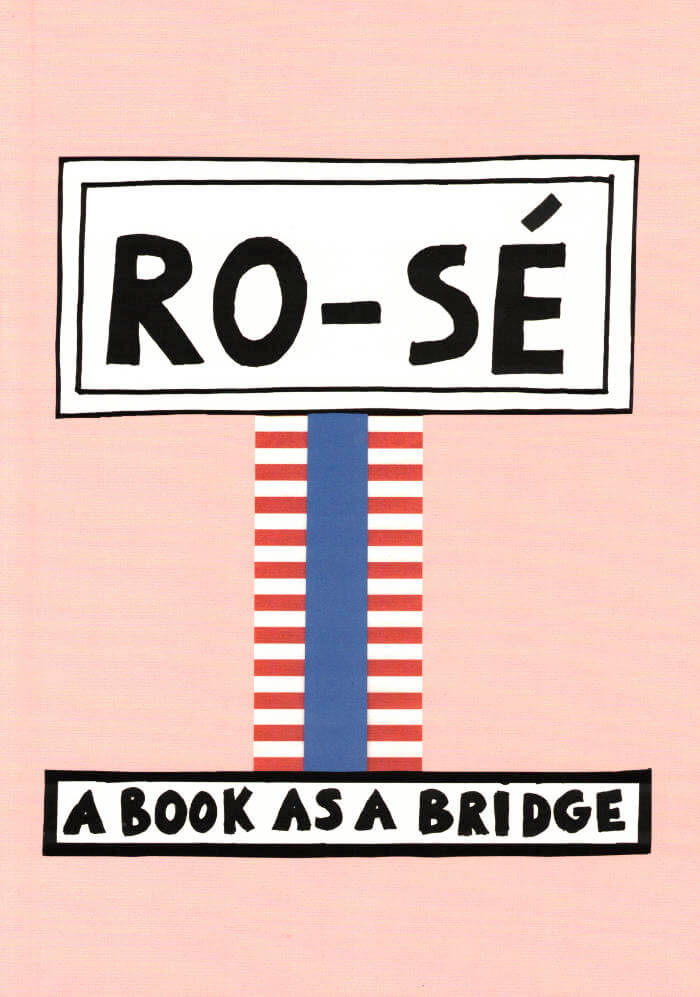
RO-SÉ – A Book as a Bridge
A hybrid monograph/artist book of Nathalie Du Pasquier's work.
Published on the occasion of Nathalie Du Pasquier's solo show at MACRO – Museum of Contemporary Art of Rome, this book navigates the space between an exhibition catalogue and the artist book with juxtapositions of photographs of Nathalie Du Pasquier' works, installation views of the show at MACRO, and extracts from texts by various writers and figures fundamental for her practice. These come together to create an extension of the exhibition itself, in a form that channels the spirit of the show: the pages become exhibition spaces embracing associations and combinations allowing for a deeper understanding and exploration of Du Pasquier's work, and her imagination at large. It is a glimpse into the possibilities offered by her oeuvre, which can be approached, interpreted, and experienced from countless perspectives. It is the very vastness and variety of her work, and her inspirations, that make the exploration of her work—and as a result this publication—non-exhaustive. This publication is part of an ongoing study of her work and documents her exhibition at MACRO, "Campo di Marte," Du Pasquier's biggest show to date which brought together over one-hundred paintings, sculptures, drawings, prints, and cabins, from the early 1980s to present day.
A famous designer and co-founder of the Memphis group in Milan in 1981, Nathalie Du Pasquier (born 1957 in Bordeaux, France, lives in Milan, Italy) accompanied the (post)modern adventure around designer Ettore Sottsass, with the creation of objects, fabrics, carpets, and furniture.
Edited by Luca Lo Pinto.

London-rose — Beauty Will Save the World
The story of failure asks one question only: What do people who lose do next? “Let the best one win.” War is one way. The other way is religion. Let me at the stakes. It’s so much a matter of patience. No fury, beyond all reason, no sequence broken, but diverted. Nothing seems to cooperate when you lose control. Blue becomes violet. Bend your head to the blank. The solution is so simple: don’t identify yourself with your description of yourself.
"It feels we aren’t reading prose but language that oscillates between liturgy and prayer." — Eugene Lim

World of Interiors
In World of Interiors I use collage and appropriation to destabilise the first-person ‘I’. I also write directly about the inescapable condition of being perceived and positioned by other people. Our lives take place in time and space, meaning in history and geography, as well as in relation to one another – not just interpersonally, but intergenerationally, with all the baggage of race, class, gender and nation that this implies. I write about economic cycles of wealth and poverty at the levels of the individual, group and state. The book is about travel and immigration: migrants, tourists and refugees. It is about the work of survival and the cost of survival. It is also a hopeful book – about how strong and indomitable the will can be.
Published April 2022
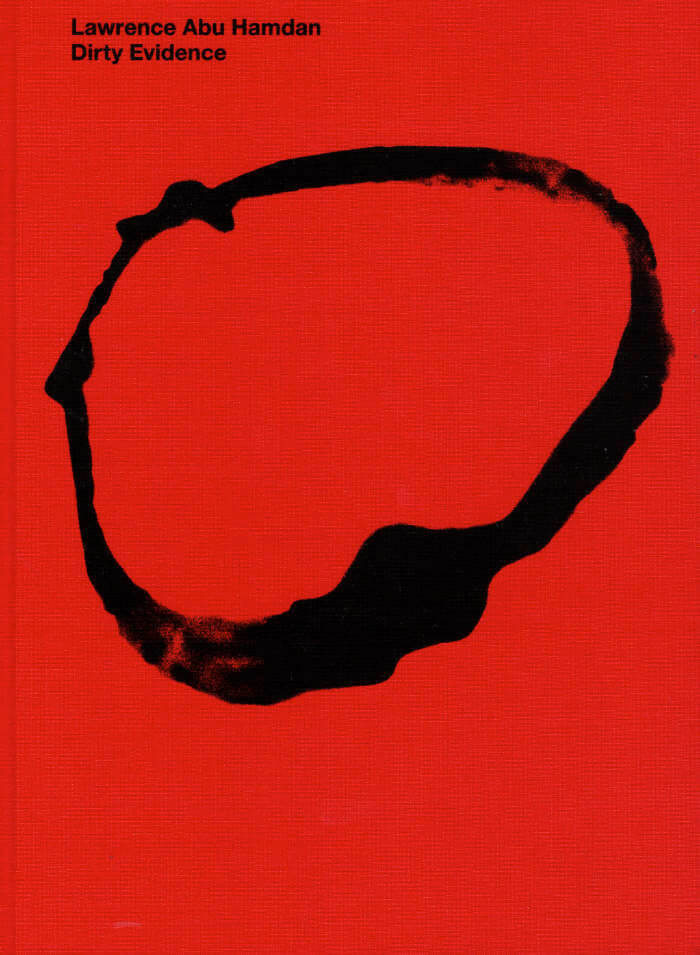
Dirty Evidence
Richly illustrated, this book provides for the first time a visual overview of Lawrence Abu Hamdan's works of more than a decade, and elaborates on a formal vocabulary characterized by the aesthetics of sound and language.
On the occasion of Lawrence Abu Hamdan's exhibition at Bonniers Konsthall in Stockholm in 2021, a group of authors have been invited to engage with individual works and their underlying concepts. Abu Hamdan recognizes the space for art as a site where attention can be drawn to real socio-political conditions in order to challenge the structures behind them. The artist can therefore push at the boundaries of what constitutes testimony. The title "Dirty Evidence" comes from Abu Hamdan's definition of evidence in which a truth value is derived from its very inadmissibility before the law. It is precisely the evidence's figurative dirt and dirtiness that works toward the production of truth.
Lawrence Abu Hamdan (born 1985 in Amman, Jordan, lives and works in Beirut, Lebanon) is an artist and “private ear” whose projects have taken the form of audiovisual installations, performances, graphic works, photography, Islamic sermons, cassette tape compositions, potato chip packets, essays, and lectures. Abu Hamdan's interest with sound and its intersection with politics originate from his background in DIY music.
Edited by Fabian Schöneich.
Graphic design: David Bennewith.
Texts by Lawrence Abu Hamdan, Natasha Ginwala, Ruba Katrib, Andrea Lissoni, Ramona Naddaff, Fabian Schöneich, Yasmine Seale, Theodor Ringborg, Eyal Weizman.

Up Your Ass
Valerie Solanas's rarely published, legendary play, Up Your Ass, explodes social and sexual mores and the hypocritical, patriarchal culture that produces them through her signature irreverence and wit, incisiveness and camp.
The play, whose full title is Up Your Ass Or From the Cradle to the Boat Or The Big Suck Or Up from the Slime, marches out a cast of screwy stereotypes: the unknowing john, the frothy career girl, the boring male narcissist, two catty drag queens, the sex-depraved housewife, and a pair of racialized pickup artists, among others. At the center is protagonist Bongi Perez—a thinly veiled Solanas—a sardonic, gender-bending hustler who escorts us through the back alleys of her street life. The fictionalized predecessor to SCUM Manifesto, the play shares the same grand, subversive, implicative language, equally spitting and winking, embracing the margins, the scum, and selling a trick along the way.
Valerie Solanas (1936-1988) is an American radical feminist intellectual, known for her SCUM Manifesto—a pamphlet with which she declares the power of women and imagines a political future through the margin—, and for having tried to assassinate Andy Warhol.
Edited by Leah Whitman-Salkin.
With a contribution by Paul B. Preciado.
Graphic design: Roxanne Maillet.

Custody of the Eyes
A story that explores how power is enacted on and through the body—the physical, the social, and the political.
Alienation and dire frustration mount as an unnamed woman—a mother—struggles to survive in the face of state repression, neighborhood surveillance, extreme weather, and familial control. Told through one side of an epistolary exchange, the novel's letters are bookended by dense ramblings by the mother's son, who struggles to speak and write and spends most of his days in lockdown rearranging his "vessels," hysterically laughing, drooling, writhing, withdrawing—a state that will ultimately consume his mother as well. This is a story that explores how power is enacted on and through the body—the physical, the social, and the political. Custody of the Eyes (Los Vigilantes) reconfirms the essential, constitutive nature of language and expression in power and freedom.
Diamela Eltit (born 1947 in Santiago, Chile) is a Chilean writer and teacher.
Edited by Leah Whitman-Salkin.
Graphic design: Roxanne Maillet.
Published in May 2022
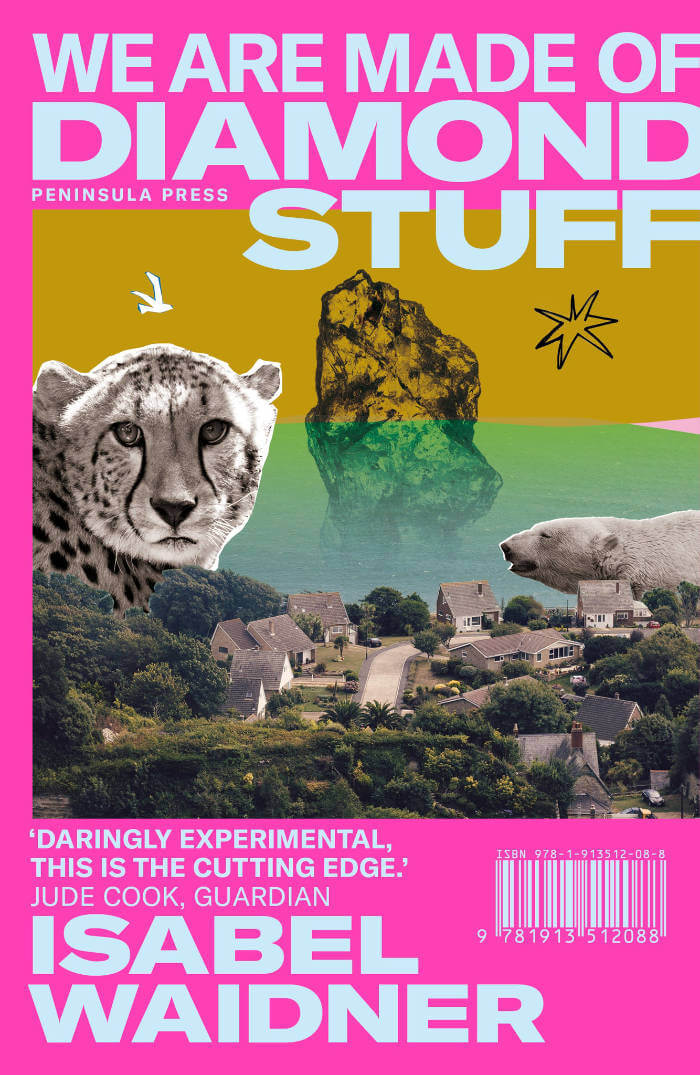
We Are Made of Diamond Stuff
Polar bears emerge from t-shirts. Reeboks come to life. Nothing is normal in the house of Mother Normal.
In Isabel Waidner’s second novel, we follow an unnamed narrator who looks like Eleven from Stranger Things, but is in fact a 36-year-old migrant working for minimum wage in a run-down hotel on the Isle of Wight. Along with their best friend, Shae, the narrator faces Ukip activists, shapeshifting creatures, and despotic bosses while trying to hold down their job and preparing for their Life in the UK test.
This is fiction that extends the avant-garde tradition beyond the upper-class experience that it usually chronicles – making it over as an ally of working-class queer experience. Set against a backdrop of austerity and decline, We Are Made of Diamond Stuff is an irreverent, boundary-erasing piece of work that celebrates the radical potential of resistance, ingenuity, and friendship.
Shortlisted for the Goldsmiths Prize and the Republic of Consciousness Prize.

Take Em' Down: Scattered Monuments and Queer Forgetting
Who determines what is remembered and commemorated, and why? How can we commemorate something that is both in the past and a daily reality? In Take 'Em Down, Simon(e) van Saarloos is inspired by the historically invisibilized lives of LGBT people and queers. They demonstrate the power of forgetting and wonder if and how it’s possible to live without a past. At the same time, Van Saarloos criticizes the way that a ‘white memory’—including their own—treats some stories as self-evident while other histories are erased.
"Amidst a global pandemic that has fundamentally changed our world, along with Black Lives Matter, Me Too, Topple Monuments Movements and ongoing struggles for LGBTQIA liberation, Simon(e) van Saarloos' Take 'Em Downasks us to reenvision monuments and acts of commemoration. They also champion forms of Queer forgetting as acts of resistance. They call upon the work of some of the greatest thinkers, scholars and writers Arendt, Orwell, Halberstam, Rankine, Moten, Hartman and more to raise critical issues around memory, mourning and social justice. In this text Saarloos joins their ranks in creating important new visions and challenges for our world. It’s a text demanding to be contemplated and shared widely."
Pamela Sneed, Author of Funeral Diva, City Lights 2020
Simon(e) van Saarloos is the author of Playing Monogamy (PS Rotterdam). They were the curator of the 2021 exhibition on Abundance (‘We must bring about the end of the world as we know it’ – Denise Ferreira da Silva) in Het HEM and are also the host of *The Asterisk Conversations podcast. Van Saarloos recently started a PhD in the Rhetoric department at UC Berkeley.
Translation by Liz Waters. Introduction by Pamela Sneed, New York-based poet, performer, visual artist, and educator.
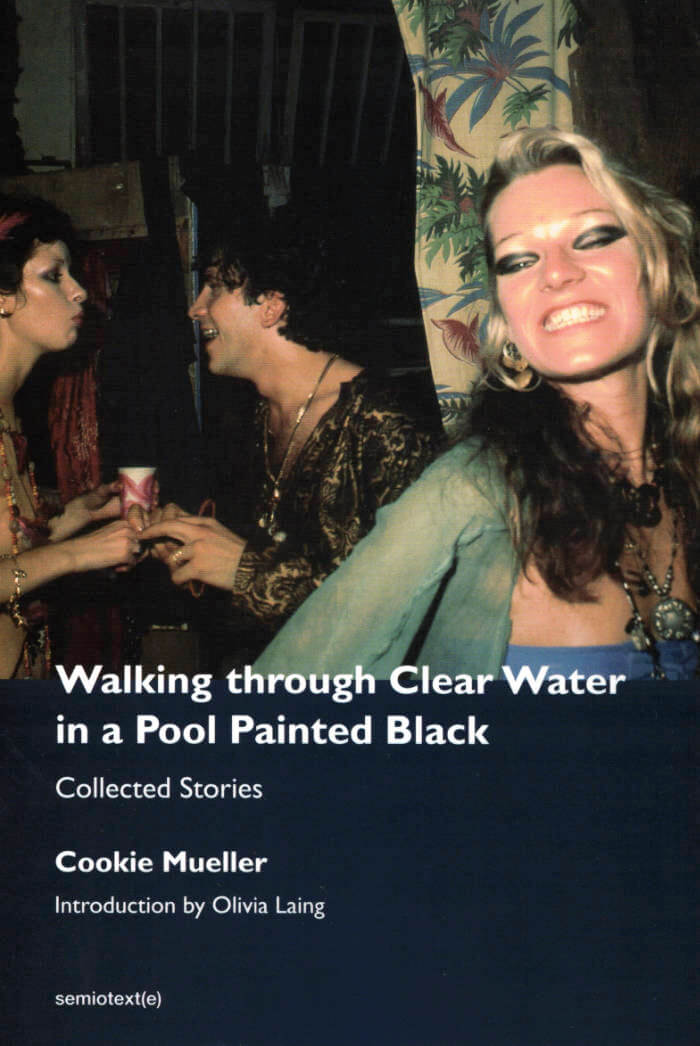
Walking Through Clear Water in a Pool Painted Black, New Edition: Collected Stories
The first collected edition of legendary writer, actress, and adventurer Cookie Mueller's stories, featuring the entire contents of her 1990 book Walking through Clear Water in a Pool Painted Black, alongside more than two dozen others, some previously unpublished.
Legendary as an underground actress, female adventurer, and East Village raconteur, Cookie Mueller's first calling was to the written word: I started writing when I was six and have never stopped completely, she once confessed. Muellerís 1990 Walking through Clear Water in a Pool Painted Black, the first volume of the Semiotext(e) Native Agents series, was the largest collection of stories she compiled during her life. But it presented only a slice of Mueller's prolific work as a writer. This new, landmark volume collects all of Mueller's stories: from the original contents of Clear Water, to additional stories discovered by Amy Scholder for the posthumous anthology Ask Dr. Mueller, to selections from Mueller's art and advice columns for Details and the East Village Eye, to still new stories collected and published here for the first time. Olivia Laing's new introduction situates Mueller's writing within the context of her life—and our times.
Thanks to recent documentaries like Mallory Curley's A Cookie Mueller Encyclopedia and Chloé Griffin's oral biography Edgewise, Mueller's life and work have been discovered by a new generation of readers. Walking through Clear Water in a Pool Painted Black: Collected Stories returns essential source material to these readers, the archive of Mueller's writing itself. Mueller's many mise en scènes—the Baltimore of John Waters, post-Stonewall Provincetown, avant-garde Italy, 1980s New York, an America enduring Reagan and AIDS—patches together a singular personal history and a primer for others. As Laing writes in her introduction, Collected Stories amounts to a how-to manual for a life ricocheting joyously off the rails, a live corrective to conformity, conservatism, and cruelty.

Boat
In 2004, boldly original poet Lisa Robertson published a chapbook, Rousseau's Boat, poems culled from years of notebooks that are, nevertheless, by no means autobiographical. In 2010, she expanded the work into a full-length book, R's Boat. During the pandemic, she was drawn back into decades of journals to shape Boat. These poems bring fresh vehemence to Robertson's ongoing examination of the changing shape of feminism, the male-dominated philosophical tradition, the daily forms of discourse, and the possibilities of language itself.
Poet and essayist Lisa Robertson has held residencies at the California College of the Arts, Cambridge University; University of California, Berkeley; UC San Diego; and American University of Paris. Her books include Cinema of the Present, Debbie: An Epic (nominated for the Governor General's Award in Canada), The Men, The Weather, R's Boat (poetry) and Occasional Works and Seven Walks from the Office for Soft Architecture (essays). Lisa Robertson's Magenta Soul Whip (Coach House) was named one of The New York Times 100 Notable Books of 2010, and was longlisted for the 2011 Warwick Prize for Writing. She won the inaugural C. D. Wright Award. She currently lives in France.
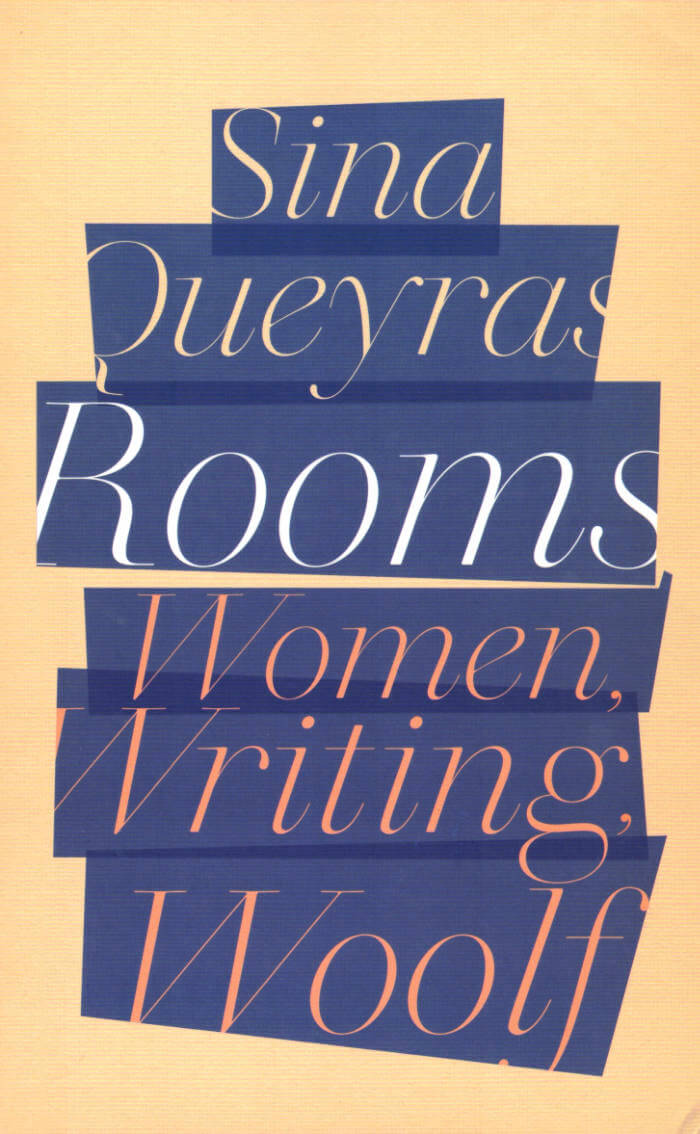
Rooms: Women, Writing, Woolf
From LAMBDA Literary Award winner Sina Queyras, Rooms offers a peek into the defining spaces a young queer writer moved through as they found their way from a life of chaos to a life of the mind.
Thirty years ago, a professor threw a chair at Sina Queyras after they'd turned in an essay on Virginia Woolf.
Queyras returns to that contentious first encounter with Virignia Woolf to recover the body and thinking of that time. Using Woolf's A Room of One's Own as a touchstone, this book is both an homage to and provocation of the idea of a room of one's own at the centre of our idea of a literary life.
How central is the room? And what happens once we get one? Do we inhabit our rooms? Or do the rooms contain us? Blending memoir, prose, tweets, poetry, and criticism, Rooms offers a peek into the defining spaces a young queer writer moved through as they found their way from a life of chaos to a life of the mind, and from a very private life of the mind to a public life of the page, and from a life of the page into a life in the Academy, the Internet, and on social media.